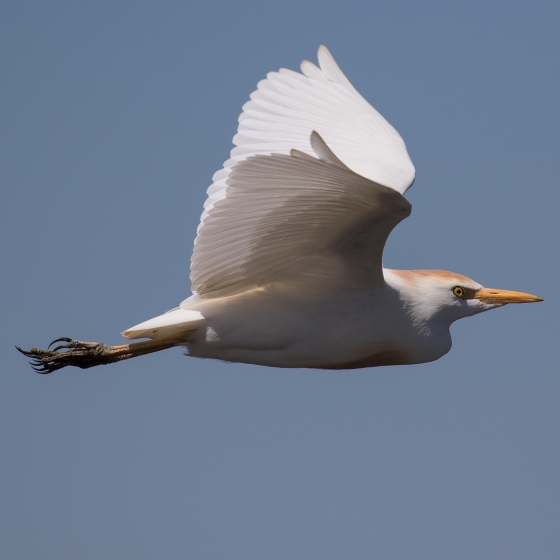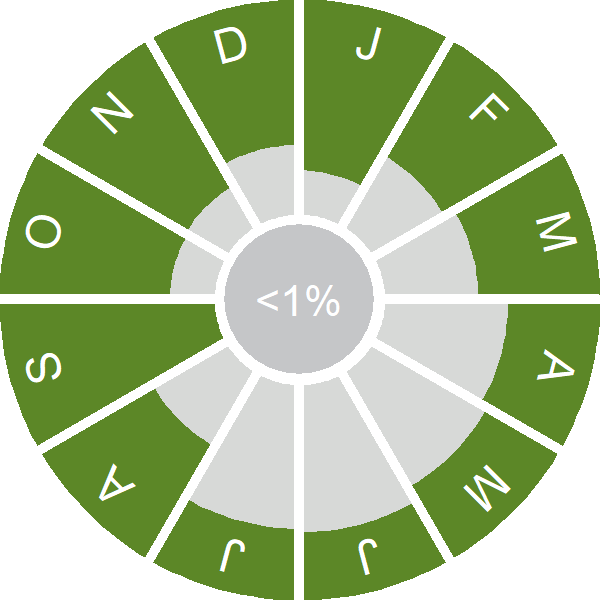Cattle Egret

Introduction
This small white member of the heron family is a recent colonist which, as the name suggests, often associates with livestock.
Cattle Egrets were first reported to have bred in Britain in 2008, with two pairs nesting in Somerset; more breeding attempts have followed and there is now a slowly expanding population in southern Britain. The colonisation that is taking place is likely supported by climate change and Cattle Egret is one of a number of heron species newly added to our breeding avifauna.
Individuals are reported from a wider area during the winter months, with records from as far north as the Scottish mainland. As might be expected for a formerly southern species, south-west England and the south of Ireland do well for records of wintering birds.

Key Stats
Identification
ID Videos
This section features BTO training videos headlining this species, or featuring it as a potential confusion species.
Cattle Egret
Songs and Calls
Call:
Other:
Status and Trends
Conservation Status
Population Change
The Cattle Egret first bred in the UK in 2008 but breeding was not confirmed again until 2017. Subsequently, the numbers of pairs and the number of sites has continued to increase rapidly and there were 10–19 breeding pairs in 2019 (Eaton et al. 2021). It is anticipated that numbers will continue to increase in the coming years.
Distribution
The maps show Cattle Egret distribution at the beginning of an unprecedented influx into Britain & Ireland in late 2007. Since then, Cattle Egrets have become established as a breeding species in several counties and wintering birds are present in many areas of southern Britain, sometimes including flocks of tens or hundreds of birds.
or view it on Bird Atlas Mapstore.
or view it on Bird Atlas Mapstore.
European Distribution Map
Distribution Change
Change in occupied 10-km squares in the UK
from 1981–84 to 2007–11
or view it on Bird Atlas Mapstore.
from 1968–72 to 2008–11
or view it on Bird Atlas Mapstore.
Seasonality
Cattle Egret is a former rare vagrant, now established breeding species and can be seen in all months of the year.
Weekly pattern of occurrence
The graph shows when the species is present in the UK, with taller bars indicating a higher likelihood of encountering the species in appropriate regions and habitats.

Movement
Britain & Ireland movement
European movements
EuroBirdPortal uses birdwatcher's records, such as those logged in BirdTrack to map the flows of birds as they arrive and depart Europe. See maps for this species here.
The Eurasian-African Migration Atlas shows movements of individual birds ringed or recovered in Europe. See maps for this species here.
Biology
Survival and Longevity
Survival is shown as the proportion of birds surviving from one year to the next and is derived from bird ringing data. It can also be used to estimate how long birds typically live.
Classification, names and codes
Classification and Codes
- Order: Pelecaniformes
- Family: Ardeidae
- Scientific name: Ardea ibis
- Authority: Linnaeus, 1758
- BTO 2-letter code: EC
- BTO 5-letter code: CATEG
- Euring code number: 1110
Alternate species names
- Catalan: esplugabous
- Czech: volavka rusohlavá
- Danish: Kohejre
- Dutch: Koereiger
- Estonian: veisehaigur
- Finnish: lehmähaikara
- French: Héron garde-boeufs
- German: Kuhreiher
- Hungarian: pásztorgém
- Icelandic: Kúhegri
- Irish: Éigrit Eallaigh
- Italian: Airone guardabuoi
- Latvian: lopu garnis
- Lithuanian: ibinis garnys
- Norwegian: Kuhegre
- Polish: czapla zlotawa
- Portuguese: garça-vaqueira / carraceiro
- Slovak: hltavka chochlatá
- Slovenian: kravja caplja
- Spanish: Garcilla bueyera
- Swedish: kohäger
- Welsh: Crëyr Gwartheg
Research
Causes of Change and Solutions
Causes of change
The colonisation of the UK has followed considerable range expansion to the north over the last 30 years, through France and also into The Netherlands (Keller et al. 2020). The causes of this range expansion are unclear but it is in line with similar recent range expansions by the Great White Egret and Spoonbill and the earlier colonisation of the UK by the Little Egret. Though speculative, it is possible that climate change has helped facilitate these range changes.
More Evidence
More evidence from Conservation Evidence.com
Partners
Citing BirdFacts
If you wish to cite particular content in this page (e.g. a specific value) it is best to use the original sources as linked in the page. For a more general citation of the whole page please use: BTO (20XX) BirdFacts Species: profiles of birds occurring in the United Kingdom. BTO, Thetford (www.bto.org/birdfacts, accessed on xx/xx/xxxx).

